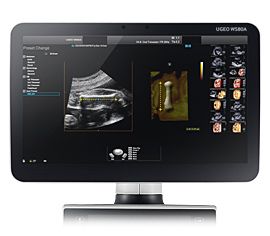
Young Han Kim1, Hee Young Cho1, Yong Won Park1, Hye-Sung Won2, Mi-Young Lee2, Bo Hyon Yun1, Kwang Hee Lee3, Sung Yoon Kim3, Junsang Yoo3, Ja-Young Kwon1 1Division of Maternal-Fetal Medicine, Department of Obstetrics and Gynecology, Yonsei University Health System, Yonsei University College of Medicine,Seoul; 2Department of Obstetrics and Gynecology, University of Ulsan College of Medicine, Asan Medical Center, Seoul; 3Samsung Medison Research and Development Center, Seoul, Korea KEYWORDS: 5D
Long Bone; Fetal biometry; Fetal long bone; Three-dimensional ultrasound; Two-dimensional ultrasound ABSTRACT Objective To evaluate the feasibility of five-dimensional Long Bone (5D LB), a new technique that automatically archives, reconstructs images, and measures lengths of fetal long bones, to assess whether the direction of volume sweep influences fetal long bone measurements in three-dimensional (3D) ultrasound and 5D LB, and to compare measurements of fetal long bone lengths obtained with 5D LB and those obtained with conventional two-dimensional (2D) and manual 3D techniques. Methods This prospective study included 39 singleton pregnancies at 26+0 to 32+0 weeks of gestation. Multiple pregnancies, fetuses with multiple congenital anomalies, and mothers with underlying medical diseases were excluded. Fetal long bones of the lower extremities— the femur, tibia, and fibula were measured by 2D and 3D ultrasound, and 5D LB, by an expert and non-expert examiner. First, we analyzed the 3D ultrasound and 5D LB data according to 2 different sweeping angles. We analyzed intra- and inter-observer variability and agreement between ultrasound techniques. Paired t-test, interclass correlation coefficient, and Bland-Altman plot and Passing-Bablok regression were used for statistical analysis. Results There was no statistical difference between long bone measurements analyzed according to 2 different volume-sweeping angles by 3D ultrasound and 5D LB. Intra- and inter-observer variability were not significantly different among all 3 ultrasound techniques. Comparing 2D ultrasound and 5D LB, the interclass correlation coefficient for femur, tibia, and fibula was 0.91, 0.92, and 0.89, respectively. Conclusion 5D LB is reproducible and comparable with conventional 2D and 3D ultrasound techniques for fetal long bone measurement. Copyright © 2015 Korean Society of Obstetrics and Gynecology

